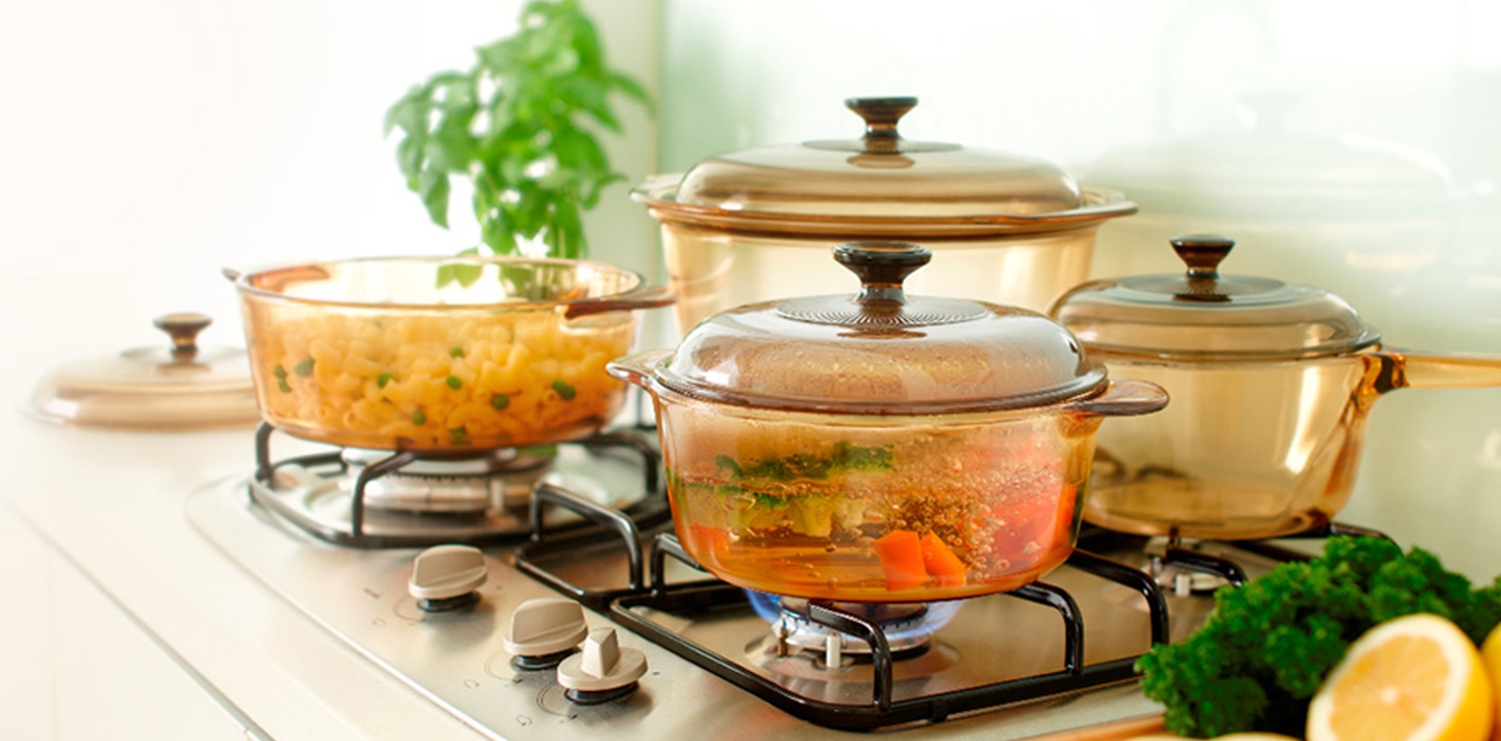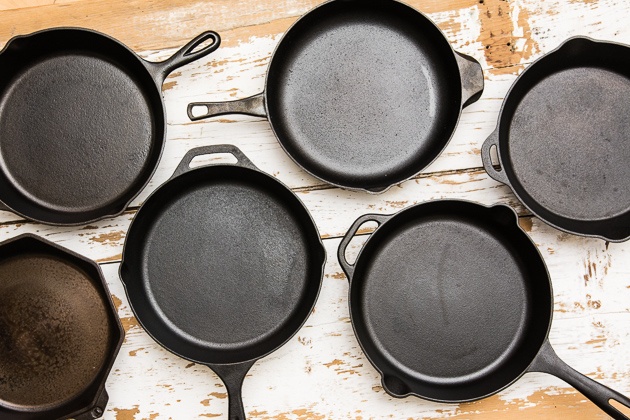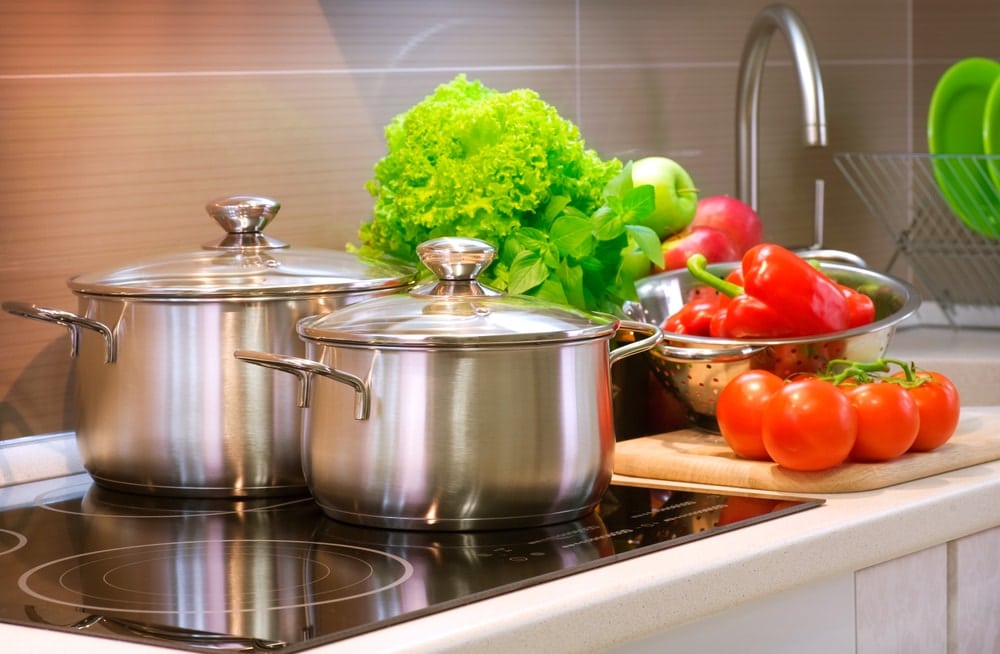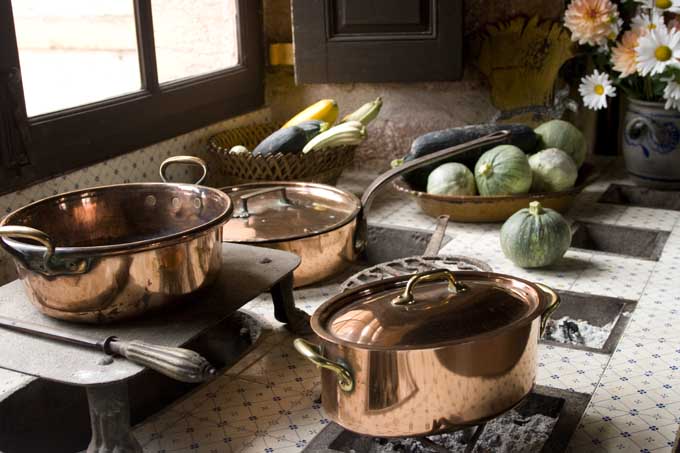4 best types of nontoxic cookware

The results of toxic cookware studies thus far should make us question what these dangerous chemicals can do to our bodies, especially when exposure is on a daily basis.
I would avoid any cookware with a nonstick coating containing artificial toxic chemicals like PFOA and PFOS as well as cookware with any type of aluminum cooking surface.
Both nonstick and aluminum cookware are known for toxic leaching when used for cooking.
Speckled metal bakeware and enamel cast iron skillets don’t have “aluminum” in their name, but have been shown to leach aluminum.
Some cookware contains nanoparticles and to date, there are no long term studies to prove their safety.
It’s much healthier to create a nonstick cooking surface using grass-fed butter or coconut oil with nontoxic cookware rather using toxic nonstick cookware.
Looking for the best cooking pots and pans? Opt for any of the following types of kitchen cookware, add a healthy fat source and start cooking. These tried-and-true kitchen cookware choices have stood the test of time. Sure, you may have to pay a bit more attention so food doesn’t stick, but in the long run it’s well worth it. You’ll get peace of mind knowing you’re protecting your loved ones from one more of the many dangerous toxins in our environments today. Get ready to toss that toxic cookware stat!
These four categories of nontoxic cookware are the only ones that I currently use:
1. Cast Iron
If you go back 100 years ago, you would find most people using nontoxic cookware in the form of cast iron pots and pans on a daily basis. Cast iron cookware is an old-fashioned favorite made from cast iron and many health experts agree it’s one of the safest cooking options available. It’s common to see it topping nontoxic cookware lists all the time.
Cast iron retains heat extremely well so you can use a lower heat setting, which is an easy way to prevent food from sticking to a pot or pan. Cast iron cookware can also stand much higher temperature than non stick cookware so you can use it on the stovetop or in the oven.
Cast iron cookware free of PFOA and PTFE should not contain any other chemicals. But there is one substance that can end up in your food with this type of cookware: iron! It’s very common to struggle with an iron deficiency and cooking with cast iron is actually a natural way to increase iron levels.
 |
The only people that wouldn’t want to be cooking with cast iron too often are inpiduals with iron stores that are too high.
To season cast iron, you simply apply a very light coating of a high smoke point oil such as avocado oil to the surface of the cookware when it is clean and ideally a little warm. Each time you use your cast iron cookware, make sure to season it after cleaning to maintain an optimal cooking surface.
2. Stainless Steel
Is stainless steel cookware safe? Along with cast iron, it’s often considered to be one of the safest of nontoxic cookware options. Real, high-quality stainless steel cookware is the perfect solution for many of your needs in the kitchen because it’s made to resist dangerous leaching and reactivity. This cookware material can resist corrosion — hence its name “stainless” steel. It also won’t flake off and end up in your food the way nonstick products can.
There are so many grades of stainless steel so first off, make sure you are buying cookware made with a food-grade version of stainless at the very least. Stainless steel is a mix of metal including carbon, chromium, nickel and/or manganese. Food-grade stainless steels include 304, 316 and 430. There’s also the specification of 18/8, 18/10 or 18/0 stainless steel. The first number specifies the percentage of chromium and the second number is the amount of nickel. The nickel actually makes the stainless still more resistant to rust or corrosions, but some people are concerned about the leaching of nickel from stainless steel so pay attention to those numbers if you are concerned about the nickel content of your stainless steel cookware.
 |
The combination of metals in stainless steel pots and pans is said to make it generally more stable and less likely to leach nickel or any other metal into food. However, if stainless steel cookware is cleaned in a harsh manner with abrasive cleaning materials, then this can result in damage to the lining. Once damaged, it’s no longer as healthy of a cooking device because the leaching of metals then becomes possible. I would make sure not to clean stainless steel too harshly and throw out any stainless steel cookware with damaged cooking surfaces.
3. Glass
Glass cookware is not just nontoxic and friendly to the environment, it’s also really durable. It’s another option to reduce the use of cookware containing polyfluoroalkyl substances (PFAS) or highly fluorinated chemicals. These dangerous compounds are added to clothing, furniture, carpeting, cookware and more to make them nonstick, waterproof and/or stain-resistant, so watch out for them in your cookware and elsewhere around your home.
For safer cooking, the EWG recommends oven-safe glass along with cast iron and stainless steel cookware. For storing foods, glass containers are also a much healthier option than plastic ones and using glass is a smart way to avoid BPA toxic effects.
 |
4. Copper
Copper falls in somewhat of an in-between category when it comes to the best nontoxic cookware. While it can be safer than other options, the risk of using 100 percent copper cookware is that it could lead to an overconsumption of copper. However, many diets are low in copper and it’s possible to have a copper deficiency especially if you suffer from a digestive disorder that generally impairs nutrient absorption. Copper toxicity from copper cookware is unlikely, but if you want to completely avoid getting any extra copper in your diet, then you wouldn’t want to choose 100 percent copper cookware.
It’s common to find copper cookware that is actually copper on the outside (great for conducting heat) but has a non-reactive stainless steel lining on the inside, so you get the best of both materials. Older copper cookware can have a tin or nickel coating and should not be used for cooking.
What About “Green Cookware”?
There are a number of brands that you’ll see when doing best nontoxic cookware searches (such as “nontoxic cookware 2016” or “safest cookware 2017”). Some of these newer “green” lines have apparently come up with healthier ways to make cookware nonstick. Some of these brands include names like GreenLife and Green Pan cookware, which both use a ceramic nonstick layer derived from sand called Thermolon. There’s also Ozeri Green Earth, which uses a nonstick coating called Greblon that does not contain PFOA or PTFE.
Xtrema cookware is another name that comes up and this is a line of ceramic cookware. Xtrema’s products were found to be “non-leaching” by an independent lab. Ceramcor makes the Xtrema line of cookware which is said to be made from “a unique ceramic clay formula that is 100% natural.” Xtrema cookware products are also said to be free of lead, cadmium and toxic heavy metals, PFOA and PTFE-free, non-scratch, nontoxic, and non-metal.
In my opinion, the concept of nonstick ceramic cookware falls in the “gray zone” right now. Some are known to contain nanoparticles, which are tiny, invisible particles with the ability to penetrate the skin and cross the blood-brain barrier. Like GMOs, engineered nanoparticles are in products on store shelves today and we’re often not even realizing it. As a scientific article published in the journal Environmental Health Perspectives points out, “Nanotechnology-enabled products are quietly proliferating on U.S. store shelves, despite nagging questions about the safety of synthetic nanoparticles and the products that contain them.”
As nanoparticles continue to show up in all kinds of products including cookware, food and cosmetics, Phil Landrigan, MD, professor and chair of community and preventative medicine at Mt. Sinai Hospital, points out that companies are including nanoparticles in their formulations even though emerging data suggests that nanoparticles could produce toxic effects due to their ability to enter the body’s cells.
The problem is that we don’t have long-term studies showing how nano-ceramic could impact human health and it wouldn’t be the first time something was available to consumers before we really knew if it was safe. So for me, I stick with more traditional cookware like cast iron to play it safe.
If you are wondering if a cookware brand contains nanoparticles, don’t hesitate to reach out to the company that make the cookware and ask them. You have a right to know what’s in the cookware you are buying or already own! If you don’t feel comfortable with the presence of a certain material in your cookware, it’s important to do your homework and go directly the maker of a particular cookware. Looking into third party evaluations of cookware is always a wise idea as well./.
( Annie Price, CHHC )
Recommended
 Handbook
Handbook
Vietnam Moves Up 8 Places In World Happiness Index
 Handbook
Handbook
Travelling Vietnam Through French Artist's Children Book
 Multimedia
Multimedia
Vietnamese Turmeric Fish among Best Asian Dishes: TasteAtlas
 Handbook
Handbook
From Lost to Found: German Tourist Thanks Vietnamese Police for Returning His Bag
Popular article
 Handbook
Handbook
Prediction and Resolution for the Disasters of Humanity
 Handbook
Handbook
16 French Films To Be Shown For Free During Tet Holiday In Vietnam
 Handbook
Handbook
Unique Cultural and Religious Activities to Welcome Year of the Snake
 Handbook
Handbook



